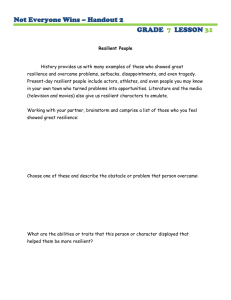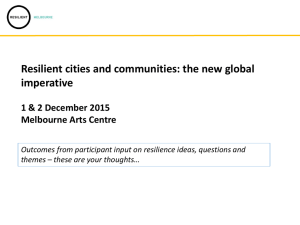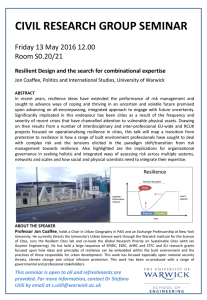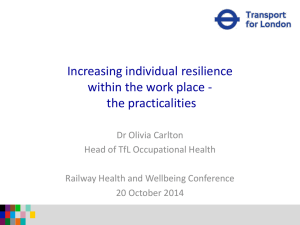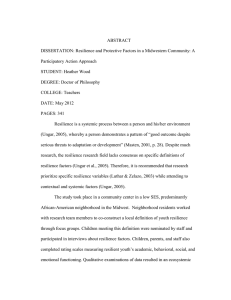Resilience as Individual Adaptation: Preliminary Analysis of a Hospital Dispensary
advertisement
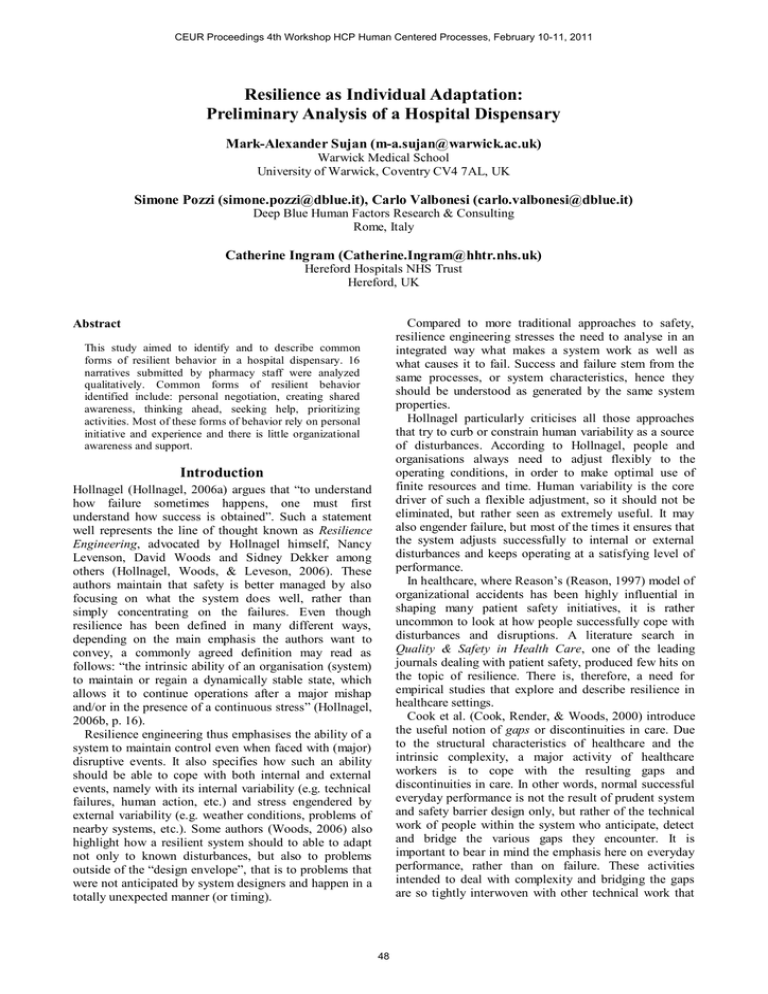
CEUR Proceedings 4th Workshop HCP Human Centered Processes, February 10-11, 2011 Resilience as Individual Adaptation: Preliminary Analysis of a Hospital Dispensary Mark-Alexander Sujan (m-a.sujan@warwick.ac.uk) Warwick Medical School University of Warwick, Coventry CV4 7AL, UK Simone Pozzi (simone.pozzi@dblue.it), Carlo Valbonesi (carlo.valbonesi@dblue.it) Deep Blue Human Factors Research & Consulting Rome, Italy Catherine Ingram (Catherine.Ingram@hhtr.nhs.uk) Hereford Hospitals NHS Trust Hereford, UK Compared to more traditional approaches to safety, resilience engineering stresses the need to analyse in an integrated way what makes a system work as well as what causes it to fail. Success and failure stem from the same processes, or system characteristics, hence they should be understood as generated by the same system properties. Hollnagel particularly criticises all those approaches that try to curb or constrain human variability as a source of disturbances. According to Hollnagel, people and organisations always need to adjust flexibly to the operating conditions, in order to make optimal use of finite resources and time. Human variability is the core driver of such a flexible adjustment, so it should not be eliminated, but rather seen as extremely useful. It may also engender failure, but most of the times it ensures that the system adjusts successfully to internal or external disturbances and keeps operating at a satisfying level of performance. In healthcare, where Reason’s (Reason, 1997) model of organizational accidents has been highly influential in shaping many patient safety initiatives, it is rather uncommon to look at how people successfully cope with disturbances and disruptions. A literature search in Quality & Safety in Health Care, one of the leading journals dealing with patient safety, produced few hits on the topic of resilience. There is, therefore, a need for empirical studies that explore and describe resilience in healthcare settings. Cook et al. (Cook, Render, & Woods, 2000) introduce the useful notion of gaps or discontinuities in care. Due to the structural characteristics of healthcare and the intrinsic complexity, a major activity of healthcare workers is to cope with the resulting gaps and discontinuities in care. In other words, normal successful everyday performance is not the result of prudent system and safety barrier design only, but rather of the technical work of people within the system who anticipate, detect and bridge the various gaps they encounter. It is important to bear in mind the emphasis here on everyday performance, rather than on failure. These activities intended to deal with complexity and bridging the gaps are so tightly interwoven with other technical work that Abstract This study aimed to identify and to describe common forms of resilient behavior in a hospital dispensary. 16 narratives submitted by pharmacy staff were analyzed qualitatively. Common forms of resilient behavior identified include: personal negotiation, creating shared awareness, thinking ahead, seeking help, prioritizing activities. Most of these forms of behavior rely on personal initiative and experience and there is little organizational awareness and support. Introduction Hollnagel (Hollnagel, 2006a) argues that “to understand how failure sometimes happens, one must first understand how success is obtained”. Such a statement well represents the line of thought known as Resilience Engineering, advocated by Hollnagel himself, Nancy Levenson, David Woods and Sidney Dekker among others (Hollnagel, Woods, & Leveson, 2006). These authors maintain that safety is better managed by also focusing on what the system does well, rather than simply concentrating on the failures. Even though resilience has been defined in many different ways, depending on the main emphasis the authors want to convey, a commonly agreed definition may read as follows: “the intrinsic ability of an organisation (system) to maintain or regain a dynamically stable state, which allows it to continue operations after a major mishap and/or in the presence of a continuous stress” (Hollnagel, 2006b, p. 16). Resilience engineering thus emphasises the ability of a system to maintain control even when faced with (major) disruptive events. It also specifies how such an ability should be able to cope with both internal and external events, namely with its internal variability (e.g. technical failures, human action, etc.) and stress engendered by external variability (e.g. weather conditions, problems of nearby systems, etc.). Some authors (Woods, 2006) also highlight how a resilient system should to able to adapt not only to known disturbances, but also to problems outside of the “design envelope”, that is to problems that were not anticipated by system designers and happen in a totally unexpected manner (or timing). 48 CEUR Proceedings 4th Workshop HCP Human Centered Processes, February 10-11, 2011 often they cannot be distinguished from it (Cook et al., 2000). In a previous paper (Pasquini, Pozzi, Save, & Sujan, 2010), we elaborated a model where risk factors were pushing the system out of control, counter-acted by resilient behaviours (or other resilient features). The model was based on the authors’ experience of how a real safety critical system works and achieves its functions, but lacked a detailed description of the resilient characteristics. Analysis The submitted narratives were analyzed qualitatively using the Nvivo software package. The software tool facilitates deep analysis of non-numerical or unstructured data, such as narratives and interviews. It supports a range of qualitative research methods including grounded theory, the approach taken in this project. The preliminary analysis and coding were done collaboratively by a domain expert (CI) and a safety expert (MAS). The codes were generated from the data. Emerging themes were discussed in a review meeting with human factors experts (SP, CV). The last part of the analysis was conducted separately by two analysts (MAS, CV) on the basis of an emerging research hypothesis. The two analysts later compared the results of their work with a third HF expert (SP), (i) to agree on the coding of specific events and (ii) to establish a shared set of codes (which will be used to continue the analysis in following research studies). The purpose of the above process was to prevent idiosyncratic interpretations by a single analyst by involving three partially separate strands of work. To counterbalance potential divergence between the three analysts, the initial research hypothesis served as a guide to orient the separate strands in a common direction. A third requirement was not to spoil the richness of field data by imposing an overly strict a priori interpretation – for instance, ideas deriving from previous researches or from the theoretical framework. The theoretical resilience engineering framework was brought into play only as a common theoretical understanding of the data, but did not orient the identification of the codes themselves. As stated above, the codes were generated by the data, with an empirical bottom-up approach. A detailed comparison of the results with “standard” resilience engineering frameworks will be performed in follow-up studies. Figure 1. The variability of a system needs to be maintained under control, by counterbalancing disturbance factors (upward arrows) with resilient behaviours (downward arrows). In this paper we present preliminary results of a qualitative analysis of resilient forms of behavior in a hospital dispensary. The next section describes the setting, as well as the data collection and analysis methods used. Then the results of the analysis are presented with empirical examples. The concluding section outlines further work. Methods Setting Results The hospital is a main provider of acute services for the West of England and parts of Wales and has a capacity of 259 inpatient beds. The pharmacy department employs 50 staff, the majority of which work in the dispensary on a rotational basis, and there are 8 staff who are based permanently in the dispensary. The preliminary analysis identified three main themes, under which most of the codes could be clustered: disturbances, feelings of frustration, coping strategies. These are explained below. Disturbances Data collection Situations that were described as disturbed or challenging in the narratives were coded as disturbance. This node arose after merging initially used nodes such as concurrent activities, excessive demand and absences into a single higher-level node. A disturbance can range from mild or frequently recurring disturbances to a crisis situation. Disturbances can be caused by internal (absence due to annual leave, people engaged in multiple activities) or external (absence due to sickness, external demand) factors. The immediate consequence of disturbances is a rise in demand and queues building up. Disturbances require adaptation and coping strategies. Depending on the success of these coping strategies the consequences of disturbances may be negligible (successful adaptation), or cause delays and lead to frustration. An example is provided below: Data was collected as part of the Health Foundation Safer Clinical Systems Program (SCS). The program was commissioned in 2008 and involves 4 NHS organizations with the aim of developing systems approaches to delivering more reliable and safer care. The data used in this paper was collected by inviting staff in the dispensary in one hospital to submit narratives about something that caused them hassle during the previous week. Staff were encouraged to use their own language and style in order to promote the idea of the narratives being a kind of reflective “safety diary”. No further guidance or restrictions were provided and the submitted narratives varied in length from one paragraph to 5 pages. In the first instance, 16 narratives were submitted (by 13 out of 34 members of staff that had been approached). 49 CEUR Proceedings 4th Workshop HCP Human Centered Processes, February 10-11, 2011 “We were short staffed due to sickness and annual leave, the phones never stopped [...] a technician rang from the ward he wanted a couple of green profiles podding down to [their ward] - a 2 second job, well so I thought. When I got there the draw was bare, someone had obviously used the last one without photocopying anymore. So, I had to leave an already short staffed dispensary to go to the copier to copy some green profiles which takes a little longer because you have to swap the paper in the machine etc.” (Example 1: disturbance) In this narrative, the subject points at internal disturbances (e.g. annual leaves, a phone call, the draw being empty) and to external ones (e.g. sick leaves), showing their impact on an already stressed system “we were short staffed […] I had to leave an already short staffed dispensary”. subject clearly anticipates a potential problem for the system (e.g. workload is going to increase). S/he then warns the Clinical Director, in order to ensure that required actions are taken before the workload increase actually happens. “About 11am [the Senior Dispensary Assistant] came to let me know that the pharmacist had a lot of work in his tray and the dispensing [Dispensary Assistants] were looking for work to do. I noticed that one of the wardbased technicians was dispensing and so asked [the Senior Dispensary Assistant] to see if she could check any patient’s own drugs to help the pharmacist.” (Example 4: personal negotiation) In this case, people report to fellow colleagues that the workload is unevenly balanced between two roles (i.e. the pharmacist and the dispensing Dispensary Assistants), making sure that a shared awareness exists of the current system status. As a consequence to that, people flexibly re-adjust their roles, by shifting one technician to a support role for the pharmacist. Other strategies to deal with disturbances include prioritization of activities and seeking help from others / offering help. Coping strategies can be proactive (e.g. freeing up resources in case they will be needed later) or reactive (prioritizing activities). Prioritization can be done based on pre-defined work flows or ad-hoc. Seeking help can differ in terms of the type of help that is required, e.g. extension of one’s own capabilities, a different set of skills. “In the afternoon a nurse came to the hatch and said that there was water on the floor in the waiting area, I was really busy catching up with my databasing and filing but as there were quite a number of people waiting and in view of patient safety I left my post to go and mop it up. It looked like a cup of water from the water machine had been knocked over.” (Example 5: ad-hoc prioritisation) “People off work sick and then there were prearranged meetings to go to. [...] We managed to keep up with our work flow of fast track items and out patients (this hadn’t given the clinical check pharmacist a chance to do standard track).” (Example 6: prioritisation based on pre-defined workflows) “About 1.20pm ward based technician came to ask if I’d like some help ACTing as there wasn’t much work in the dispensing tray - I said yes please!!” (Example 7: offering help) The three examples show three different ways of prioritising work to optimise time and resources. In the first case, optimisation takes the form of interrupting the current activity to carry out a more urgent one (no harm can arise from temporarily interrupting the database work, while someone can slip on the water). In the second case, a staff shortage (caused by sick leaves) is managed by relying on two pre-defined workflows (fast track items and standard track items). The third case is a case of help self-offer, based on the recognition that workload is currently low in the ward, but it may be instead high in the dispensary. Feelings of frustration Feelings of frustration express the personal emotional reaction to working situations and fall under the larger category of consequences of disturbances. However, in order to emphasise the emotive nature of frustration, it was decided to keep it as a separate category. Frustration can vary in its intensity ranging from a feeling that one isn’t getting anywhere to being very annoyed and upset with oneself or colleagues. Frustration expresses (is caused by) a dissatisfaction with the performance or behaviour of others, of the organisation or with oneself. The consequences of frustration are not clear from the narratives, but may have a negative impact on the coping strategies outlined below, including unwillingness to communicate with others (ask for help, provide help) and not sharing information. An example from the narratives: “Phoned [Location A] with a query about a prescription, which I had to explain the full story to 3 nurses, only to find by the third nurse that the patient had already gone home and the prescription was no longer required – very frustrating!”. (Example 2: feeling frustrated) In this example, the individual reports the feeling of frustration following an episode of time consuming communication with different individuals at another location that turned out to be needless since the information was no longer required. Coping strategies Strategies to cope with disturbances often involve personal negotiation and sharing of information about the current situation in order to create a shared awareness: “Lead technician made me aware that the CT scanner had been down and there were 37 patients waiting for an appointment, if the scanner was fixed later today, we may see an impact. This would increase the workload on an already busy day. I told lead technician that I’d chase this up with [the Clinical Director] to find out if there was anything we could do to prepare for this.” (Example 3: creating shared awareness) In this case the disturbance is an internal one (e.g. a technical failure like the CT scanner being down) and the 50 CEUR Proceedings 4th Workshop HCP Human Centered Processes, February 10-11, 2011 Aldershot, UK; Burlington, VT: Ashgate Publishing Limited. Pasquini, A., Pozzi, S., Save, L., & Sujan, M.-A. (2010). Requisites for Successful Incident Reporting in Resilient Organisations. In E. Hollnagel, D. Woods & J. Wreathall (Eds.), Resilience Engineering in Practice: A Guidebook. Aldershot, UK: Ashgate. Reason, J. (1997). Managing the risks of organizational accidents. Hampshire, UK: Ashgate Publishing Limited. Woods, D.D. (2006). Essential Characteristics of Resilience. In E. Hollnagel, D.D. Woods & N. Leveson (Eds.), Resilience engineering : concepts and precepts (pp. xii, 397 p.). Aldershot, UK; Burlington, VT: Ashgate Publishing Limited. Conclusion The hospital dispensary is an environment that faces challenges both due to internal as well as external factors. Internal factors include issues such as staff on annual leave, staff being unavailable due their being out on wards or being engaged in multiple activities. External factors relate predominantly to the nature of the work (incoming prescriptions) that is dependent on work flows in other parts of the hospital. The narratives describe an environment that is frequently very busy and stretched, but that is at the same time able to adjust and to adapt to these challenges. The preliminary qualitative analysis of the narratives identified a number of coping strategies that enable the dispensary to deal with the challenges in a resilient way: personal negotiation, creating a shared awareness, prioritization of activities, offering and seeking help from others. As maintained by Hollnagel, human variability is a key feature to adjust and adapt to current demands, as there are cases of role swapping, dynamic prioritization based on local demands and relative urgency, active monitoring of workload uneven distribution, or anticipation of likely problematic future demands. It is interesting to note that only prioritization of activities is supported at an organizational level through pre-defined urgent and standard workflows. The vast majority of resilient forms of behavior exhibited by the dispensary are the result of personal initiative, negotiation and experience. No training is provided for such skills and there are no mechanisms in place to capture and to document valuable experiences. The analysis is a first step towards a more comprehensive, empirically constructed framework of resilience in healthcare environments. Such a framework should allow healthcare organizations to identify training opportunities in non-technical skills as well as to institutionalize resilience. Acknowledgments This work has been supported in part by the Health Foundation (Registered Charity Number: 286967) as part of the Safer Clinical Systems program. We would like to thank all the pharmacy staff who contributed narratives. References Cook, R.I., Render, M., & Woods, D.D. (2000). Gaps in the continuity of care and progress on patient safety. British Medical Journal(320):791-794. Hollnagel, E. (2006a). Resilience-The challenge of the unstable. Aldershot, UK: Ashgate Publishing Limited. Hollnagel, E. (2006b). Resilience – the Challenge of the Unstable. In E. Hollnagel, D.D. Woods & N. Leveson (Eds.), Resilience engineering : concepts and precepts (pp. xii, 397 p.). Aldershot, UK; Burlington, VT: Ashgate Publishing Limited. Hollnagel, E., Woods, D.D., & Leveson, N. (2006). Resilience engineering : concepts and precepts. 51

